Caprinid-human hybrids
Goat or Sheep × Human
Myth and early reports
Mammalian Hybrids
|
Gray Superstition’s whisper dread
Debarred the spot to vulgar tread; For there, she said, did fays resort, And satyrs hold their sylvan court, By moonlight tread their mystic maze, And blast the rash beholder’s gaze.
—Sir Walter Scott
The Lady of the Lake |
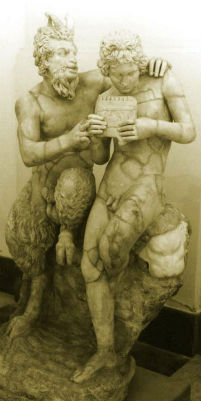 Pan teaching the shepherd Daphnis to play the pipes. Roman copy of Greek original (found at Pompeii, therefore dating to before 79 CE).
Pan teaching the shepherd Daphnis to play the pipes. Roman copy of Greek original (found at Pompeii, therefore dating to before 79 CE).
Note: Caprinids are members of the division (Caprinae) of Family Bovidae that includes goats and sheep.
In his biography of Sulla, Plutarch gives the following account of a satyr. Satyrs, which many Romans believed actually to exist, were supposed to be creatures half goat and half human (like Pan in the image at right).
A nineteenth-century news report gives an account of an incoherent satyr reminiscent of Plutarch’s:
“The residents of Jeffersonville, Ind., were startled a few days ago, it is reported, at sight of a strange being passing through the town. The freak was a negro, who walked on all fours, and whose body in many respects resembled that of some animal. His hands and feet looked like hoofs. He could not talk so anyone could understand him, and was supposed to be bound for Cincinnati.”
Source: The Kimball Graphic, (May 11, 1888, p. 4, col. 5), a newspaper published in Kimball, South Dakota.
The Nymphaeum near Apollonia was sacred to the god Pan and to the nymphs, the female nature entities of ancient myth, and the supposed frequent prey of lustful satyrs. In fable, they often accompany the higher divinities, in particular Apollo, and rustic gods such as Artemis, Dionysus, Pan, and Hermes (as the god of shepherds).
The Greeks used the word satyr to refer to a different sort of animal. Instead of goat-human hybrids, as the Romans imagined them, a Greek would have described a satyr as a cross between a human and a horse, more like a centaur. But by Roman times satyrs had morphed in the popular imagination into goat-human creatures and were generally conflated with fauns, which were also human above and goat below (see the paintings of fauns on this page). Generally speaking, however, satyrs were more lusty than fauns.
Classical literature is rife with accounts such as Plutarch’s, and the authors of these stories often represented them as real events. A passage in Pausanius (Description of Greece, 1.23.5-6) is an example:
In his geographical description of the Roman Empire, Pliny (5.1.7), while giving what supposedly was a factual account of the Atlas Mountains in northwestern Africa, mentions that at night its highest peak
In Roman times it was widely accepted that humans could hybridize with animals (which seems more reasonable than is now generally believed, given that the hundreds of reports relating to such hybridization that have been documented elsewhere on this website). Thus, in his De Natura Animalium (VI, 42), the Roman author Aelian (c. 175 - c. 235 CE) tells a story that reflects a belief in, and even an approval of, events that most people today would regard as myth, and that many would even reject as obscene and impossible.
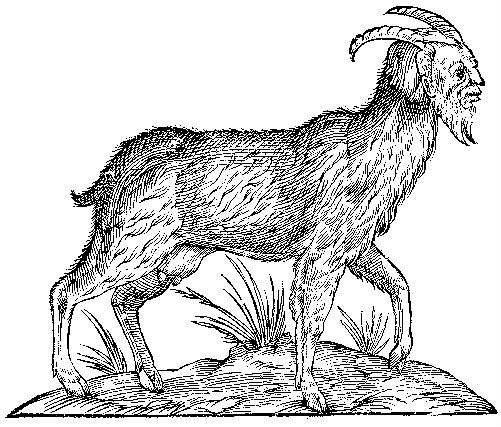 Aldrovandi's depiction of the goat-human of Sybaris. Aldrovandi, who cited Caelius Rhodigenius, thought this event occurred in 1547.
Aldrovandi's depiction of the goat-human of Sybaris. Aldrovandi, who cited Caelius Rhodigenius, thought this event occurred in 1547.
In very ancient times in Egypt and Mesopotamia such hybrids were not only accepted, but even viewed in a sacred light. And it seems that human-animal hybrids were interpreted as prodigious avatars of the gods, even as they still are among the Hindus today. Indeed, it seems that there were even attempts to produce such “deities,” which Christians later chose to forget. As the English cleric Edward Topsell (circa 1572 - 1625) commented in The History of Four-footed Beasts,
Thus, Budge (Gods of the Egyptians, 1904, p. 353) writes: “At several places in the [Nile] Delta, e.g., Hermopolis, Lycopolis and Mendes the god Pan and a goat were worshipped. Strabo, quoting (17.1.19) Pindar, says that in these places goats had intercourse with women. Herodotus (2.46) instances a case which was said to have taken place in the open day (excerpted from Macaulay 1890):
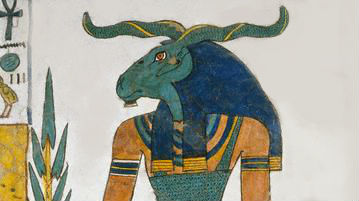 The Egyptian god Khnum, a sheep-human hybrid
The Egyptian god Khnum, a sheep-human hybrid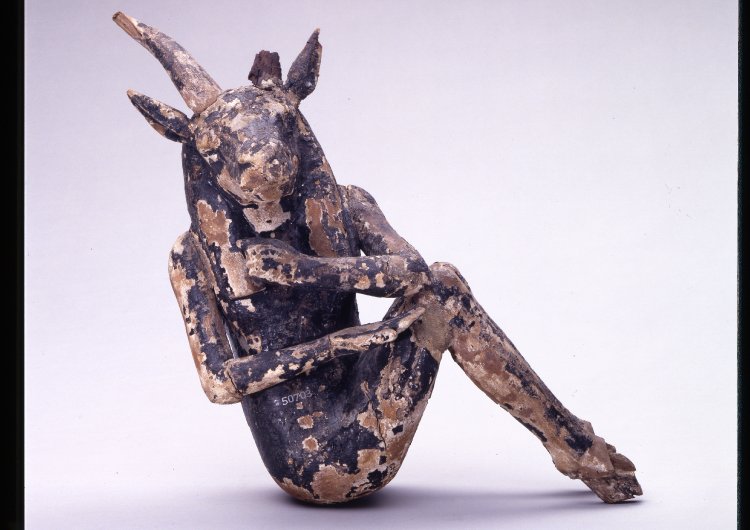 Goat-human or gazelle-human hybrid (Egyptian, 18th Dynasty, Collection of the British Museum).
Goat-human or gazelle-human hybrid (Egyptian, 18th Dynasty, Collection of the British Museum).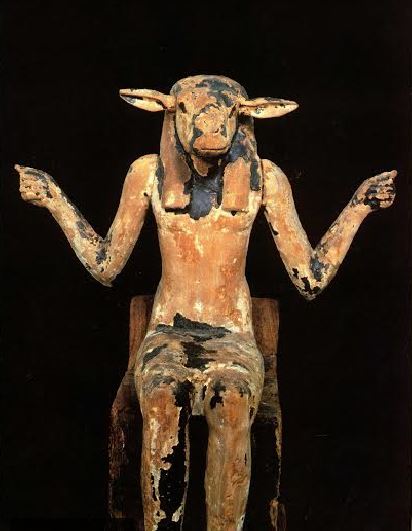 Sheep-human hybrid (Egyptian, 18th Dynasty).
Sheep-human hybrid (Egyptian, 18th Dynasty).
Indeed, it seems the Egyptians were far more intimate with animals than would be considered normal in Western culture today, or even in certain other ancient cultures. Herodotus (c. 484 – c. 425 BC), who was an eyewitness of their customs, listed many ways in which the people of the Nile differed from those of other nations. He saw one such difference in their relationships with animals. "All other men pass their lives separate from animals, the Egyptians have animals always living with them" (Persian Wars, II.36).
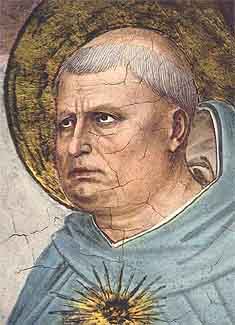 St. Thomas Aquinas
St. Thomas Aquinas1225 - 1274 A.D.
But even the Jews, who had severe laws against sexual contact with animals, must have had transgressors among them who did engage in such acts. Otherwise, the laws would have been unnecessary. And in the Old Testament there are various references to such behavior. It is widely said that it was sheerly out of jealousy that the brothers of Joseph sold him into slavery in Egypt. But it seems that English translations of their motives have been sanitized. In the Vulgate (Genesis 37:2) it is stated that after tending the flocks with his brothers, he went to his father and “accused them of the worst of crimes” (“accusavitque fratres suos apud patrem crimine pessimo”). This is confirmed by St. Thomas Aquinas, who, in the Summa Theologica (II-II, 154, 12), states that the most grievous sin “is the sin of bestiality, because use of the due species is not observed. Hence a gloss on Gn. 37:2, ‘He accused his brethren of a most wicked crime,’ says that ‘they copulated with cattle.’” So their motive for selling Joseph was much stronger than mere jealousy. The penalty for the crime he had accused them of was death.
 St. Jerome
St. Jerome347 - 420 A.D.
On into the Christian era, reports about humano-caprinids continued to crop up. St. Jerome in The Life of Paul the First Hermit (§8), states that during the reign of Constantine (306 to 337 A.D.), a goat-human or satyr “was brought alive to Alexandria and shown as a wonderful sight to the people. Afterwards his lifeless body, to prevent its decay through the summer heat, was preserved in salt and brought to Antioch that the Emperor might see it.” Jerome adds that “it was a matter of which the whole world was witness.”§ With regard to this creature, Topsell (ibid) remarked that
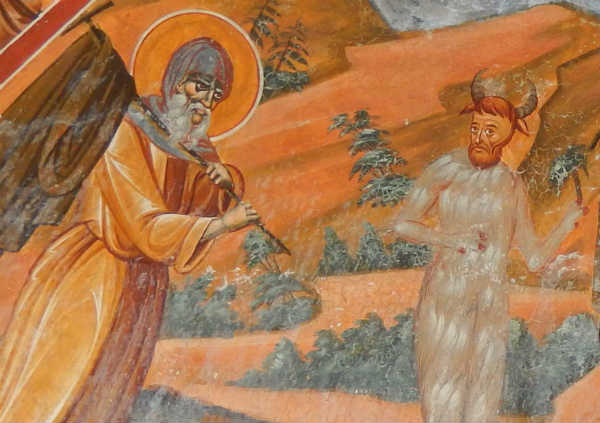 St. Anthony and the Satyr (Detail from the Skete of Saint Demetrius, Vatopedi, Mount Athos, Greece). In The Life of Paul the First Hermit, which was written in the year 374 or 375, Jerome describes how Anthony supposedly encountered a satyr in the Syrian Desert. He also states that such a creature was brought to Constantinople during the time of Constantine.
St. Anthony and the Satyr (Detail from the Skete of Saint Demetrius, Vatopedi, Mount Athos, Greece). In The Life of Paul the First Hermit, which was written in the year 374 or 375, Jerome describes how Anthony supposedly encountered a satyr in the Syrian Desert. He also states that such a creature was brought to Constantinople during the time of Constantine.
In another early account, Johann Carion (Chronica, 1588, p. 614) records that under the reign of the Byzantine emperor Michael VII Doukas (1071 to 1078), a woman gave birth to a cyclopean child with the feet of a goat and a single eye in the middle of its forehead.
 Pierre Bayle
Pierre Bayle(1647-1706)
During the Dark Ages—when Christian jurists came widely to believe that Satan made a habit of seducing witches in animal form, often that of a goat—any seeming half-human birth came to be viewed as a manifestation of great evil. And up until about 1700, any woman who gave birth to such an offspring ran a grave risk of being burnt at the stake. Indeed, Satan himself was often depicted as a goat-human hybrid, similar in aspect to the pagan god Pan.
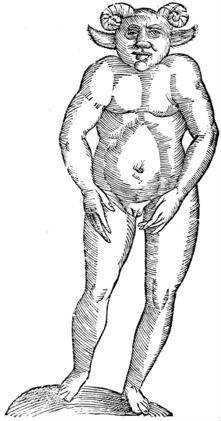 A sheep-human hybrid that, according to Aldrovandi (1642, p. 457), was born in France in the 16th century.
A sheep-human hybrid that, according to Aldrovandi (1642, p. 457), was born in France in the 16th century.
Writing during the reign of Elizabeth I, Batman (1581) tells of a cyclops found in England that, from his account, he clearly believed to be a human-sheep hybrid. His comments are those of an individual, but their tone reflects the marked shift in attitude society had undergone since ancient times with respect to such matters. What to the pagan had been a mere foible, to the Christian had become a black sin against nature.
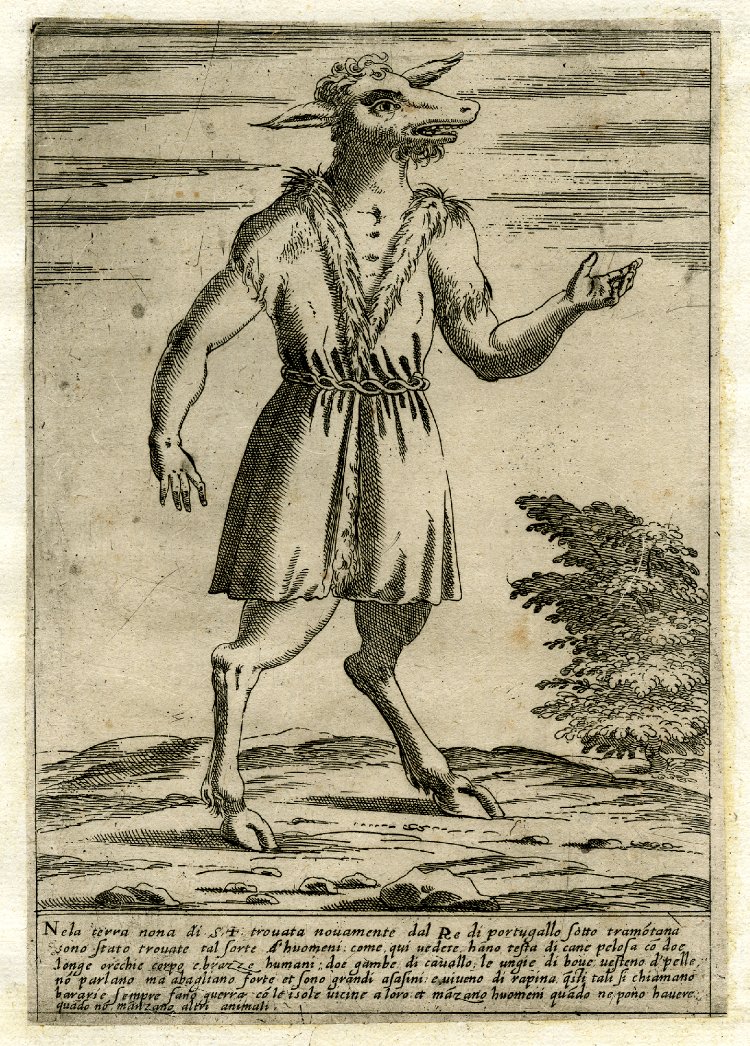 A Renaissance etching of a caprinid-human hybrid "lately found in the new possessions of the King of Portugal" (Giovanni Battista de' Cavalieri, Opera nel a quale vie molti Mostri de tute le parti del mondo antichi et moderni ..., 1585, Collection of the British Museum).
A Renaissance etching of a caprinid-human hybrid "lately found in the new possessions of the King of Portugal" (Giovanni Battista de' Cavalieri, Opera nel a quale vie molti Mostri de tute le parti del mondo antichi et moderni ..., 1585, Collection of the British Museum).
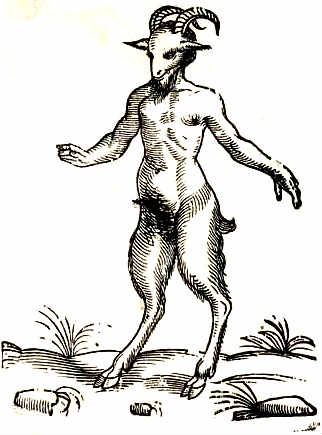 Topsell’s picture of “Aegopithecus”
Topsell’s picture of “Aegopithecus”
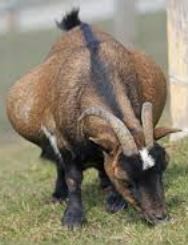 A pregnant nanny
A pregnant nanny
The seventeenth-century writer Johannes Praetorius (Neüliche Miß-Geburten, 1678) reports that in the German town of Plößte a lamb with a human face was birthed by a ewe on the 28th of March, 1670. He says it had a naked body and lamb-like ears.
Also in Germany, Christian Lehmann (1611-1688) describes an infant born to the wife of a certain Hans Bäßer, a resident of Weipert, in 1678. He says this “horrific monstrosity” (“heßliche Mißgeburt”) had a goat’s head with two horns on its forehead and goat’s eyes on its cheeks.
In his book describing various cases of medical interest, Amsterdam surgeon Job van Meekeren (Observationes medico-chirurgicae, 1682, p. 353) reported that in 1655 in the public market at Amsterdam a little girl had been put on exhibit who was completely covered in hair like that of a goat, especially on the chin, and that the exhibitors claimed her mother had been impregnated by a billy.
And van Meekeren's contemporary, the German physician Gabriel Clauder (1688, pp. 328-330), published in a medical journal an article describing an event that he said took place in the village of Schleenhain, two miles from his own place of residence (Leipzig) in 1688. There, according to Clauder, a goat gave birth to a fetus that was "in many ways similar to a human being." It had a completely naked white skin, he said, and head and ears like a human, except that there were merely two pits in place of eyes.† The legs and body, however, were “nearly like those of a goat.” It had been dead in the womb for several days.‡ The same nanny gave birth to an ordinary, living kid about an hour later.
‡ The incidence of stillbirth is elevated in many hybrid crosses.
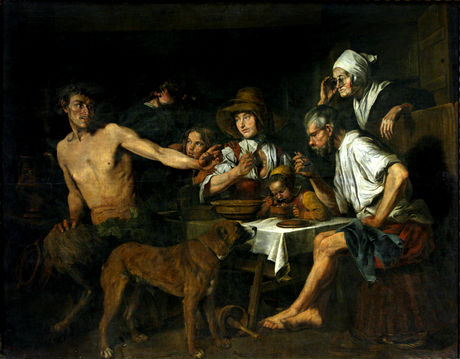 Satyr as a Guest of the Peasant by Jan Cossiers
Satyr as a Guest of the Peasant by Jan Cossiers
 Tulp
Tulp
The Dutch surgeon Nicolaes Tulp (1593-1674) was the mayor of Amsterdam and seems to have been the first European scientist to publish a description of the chimpanzee. As did many other physicians of his day, he wrote up for the benefit of his colleagues a compilation of the more interesting cases he had seen in private practice. One such was that of “The Bleating Youth” (Juvenis balans†), where Tulp describes a youth who grew up among wild sheep in Ireland and who had certain sheep-like characteristics, quoted in translation here.
In 1946, in a case paralleling that of the Tulp’s Juvenis balans, news reports (Report #1, Report #2) told of a boy captured in the Syrian Desert who was living with gazelles and who supposedly could run twice as fast as any other human being, this despite the fact that his estimated age was only ten. Extremely thin and unable to speak, according to the reports, he was brought to Damascus and was never allowed to return to the wild, despite repeated attempts to escape.
Tulp’s account of the bleating youth has interesting parallels to the descriptions of Enkidu, the Mesopotamian half-man half-bovine demigod who is one of the main characters in the Epic of Gilgamesh. His body was similar to that of both the Greek god Pan and the Christian Devil (human torso, arms and face, hairy legs with cloven hooves, horns on head). The following account of Enkidu’s origin is from my own English reconstruction of the ancient epic:
Arūru, to give them succor. She formed
damp clay, cast it into the wilderness,
watched as Enkídu’s warrior sinews warmed
to life. He was the image of Ánu,
great Lord of Sky. This wild Enkídu,
the king’s balancing spirit (his “zíkru”),
was untame (because he was lullú).
This zíkru knew nothing of men and priests,
and cared nothing at all for their daughters.
Enkídu came hurrying after the beasts,
when their hearts grew light in the waters.
He was a being of forest and rock,
who clung to nature and shunned the walled town.
His was a spirit that moved with the flock—
He had with none, except shepherds, renown.
Thus, when Nínsun said to seek his zíkru,
Gílgamesh wondered if he could be found—
this was no town-spawned human— He clove to
woods and wilds where secret places abound.
But a trapper had seen him already
that day, leaping with gazelles and standing
with the herds. The stunned man came back, said he
had watched him cavorting with deer, banding
with beasts. He told how he’d dreaded the gore
of hircine horn, cringed at Enkídu’s gaze.
He could not endure this wild being’s roar
(a beastly bellow of no human phrase).
Read news reports about caprinid-human hybrids >>
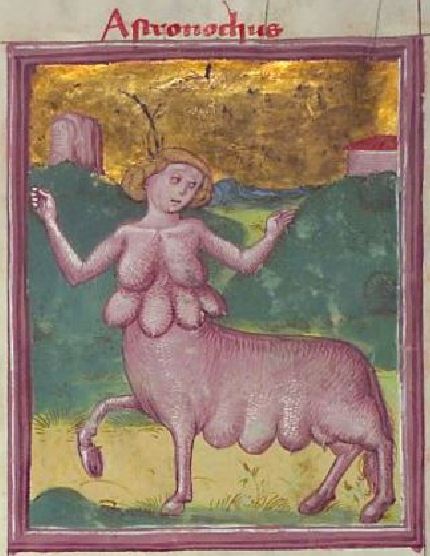 A sheep-human hybrid (Heidelberger Schicksalsbuch, p. 92).
A sheep-human hybrid (Heidelberger Schicksalsbuch, p. 92).
By the same author: Handbook of Avian Hybrids of the World, Oxford University Press (2006).